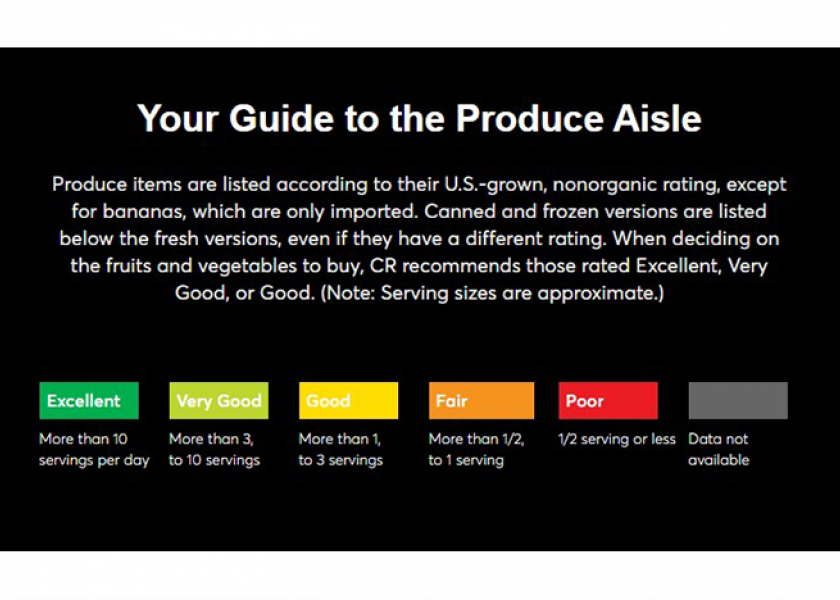Consumer Reports releases produce ratings based on pesticide residue

Consumer Reports has published a list that rates dozens of fresh produce items based on pesticide residue.
The ratings use the same Environmental Protection Agency reports that the Environmental Working Group uses for its annual “Dirty Dozen” and “Clean 15” lists.
The EPA’s reports show that pesticide residue levels on more than 99% of produce samples tested are well below allowed limits, and on many samples there is no detectable pesticide residue. Consumer Reports contends the research that supports EPA limits is inadequate and that limits are too high.
The new Consumer Reports ratings “reflect the number of servings of a particular fruit or vegetable a person can eat per day over a lifetime before the pesticides pose potential harm,” the organization wrote in its announcement of the ratings.
Consumer Reports categorizes 35 fresh produce items, and some fruits and vegetables in other forms, as either “Excellent” (defined as OK for more than 10 servings per day for a lifetime), “Very Good” (3-10), “Good” (1-3), “Fair” (1/2-1) or “Poor” (1/2 or less).
Thirty-one of 49 conventional fruits and vegetables, including forms other than fresh, rated “Good” or better, “but for the 18 non-organic fruits and vegetables with a ‘Fair’ or ‘Poor’ rating, CR’s experts say everyone, especially pregnant women, infants and young children, should try to eat the organic versions,” Consumer Reports wrote.
“If you can’t find them at a price you can afford, choose a higher-rated similar alternative, such as broccoli instead of green beans. Still, if that’s not possible, occasionally eating a low-rated fruit or vegetable doesn’t pose a serious health risk,” the organization wrote.
The Alliance for Food and Farming, a produce industry-led organization that educates consumers on the safety of fresh fruits and vegetables, has asserted that the Environmental Working Group’s “Dirty Dozen” and “Clean 15” lists are harmful because they disparage fruits and vegetables produced to food safety standards and create confusion among consumers, many of whom already aren’t eating nearly as much produce as medical professionals recommend.
The alliance expressed the same sentiment about the new Consumer Reports ratings.
While Consumer Reports acknowledged that people need to eat more, not fewer, fruits and vegetables, it recommended organic and advised people to avoid certain conventional produce items based on its ratings.
Conventional produce rated “Poor” by the organization included imported summer squash, domestic and imported green beans, domestic potatoes, domestic and imported spinach (and domestic organic spinach), imported strawberries, domestic and imported cherries, and domestic and imported peaches.
“Consumers have yet another guide or list to further confuse them when shopping for fruits and vegetables,” the Alliance for Food and Farming wrote in a news release. “Despite government programs consistently showing that 99.8% of foods sampled have residues well below (EPA) safety standards and almost 50% of those foods have no detectable residues at all, consumers continue to receive inaccurate and conflicting advice on what to eat by certain groups who strive to promote one production method over another.”
The Alliance for Food and Farming also argues that, with pesticide residue as the sole focus of Consumer Reports’ advice to consumers regarding fresh produce, the extensive nutritional benefits of fruits and vegetables are severely undersold.
“One peer-reviewed study found that 20,000 cancer cases could be prevented annually if half of Americans increased their consumption of fruits and vegetables by a single serving each day,” AFF wrote in the release. “Or (take for example) the recent study from Tufts University which determined that prescriptions for healthy foods could save more than $100 billion in healthcare costs.
“Somehow the decades of nutritional studies which show that a diet rich in organic and conventional fruits and vegetables leads to better health and a longer life are rarely mentioned or given only cursory attention (by Consumer Reports),” Alliance for Food and Farming wrote.
The organization noted that another peer-reviewed study found that messaging around pesticide residue and produce is especially damaging for low-income consumers, who reported that such messages make them less likely to purchase any fruits and vegetables.







